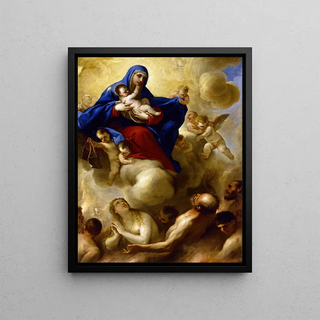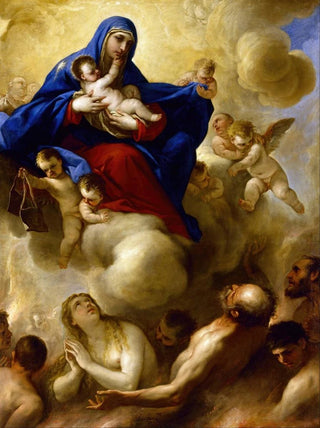Art print | The Virgin and Child with the Souls in Purgatory - Luca Giordano


View from behind

Frame (optional)
Art print La Virgin and Child with the Souls of Purgatory - Luca Giordano – Captivating Introduction
In the vast panorama of art history, certain works stand out for their ability to capture the very essence of human spirituality. "La Virgin and Child with the Souls of Purgatory" by Luca Giordano is a perfect example. This piece, imbued with emotional depth and symbolism, invites the viewer to reflect on life, death, and the beyond. Giordano, master of Neapolitan Baroque, succeeds in creating a mystical atmosphere where maternal tenderness blends with the gravity of souls seeking redemption. The scene, where the Virgin Mary presents her child to the souls of Purgatory, evokes a poignant connection between the divine and the human, offering a vision that is both comforting and unsettling.
Style and uniqueness of the work
Luca Giordano's style is characterized by a dynamism and expressiveness that animate his compositions. In "La Virgin and Child with the Souls of Purgatory," he deploys a palette of vibrant colors, where lights and shadows coexist to create a lively atmosphere. The figures are rendered with such vividness that they seem almost to come alive before the viewer's eyes. The gestures of the characters, particularly that of the Virgin, are imbued with infinite tenderness, contrasting with the gravity of the waiting souls. This play of light and color, typical of Baroque, emphasizes the intensity of emotions and the depth of the themes addressed. The work also stands out for its balance between realistic representation of the figures and a certain idealization, typical of Giordano's style, which manages to transcend mere representation to touch the very essence of feelings.
The artist and his influence
Luca Giordano, born in Naples in 1634, is one of the most prolific artists of his time. His career is marked by an incessant quest for innovation, drawing inspiration from both the masters of the past and contemporary trends. Giordano successfully integrated elements of classicism while adopting the characteristics

Matte finish

View from behind

Frame (optional)
Art print La Virgin and Child with the Souls of Purgatory - Luca Giordano – Captivating Introduction
In the vast panorama of art history, certain works stand out for their ability to capture the very essence of human spirituality. "La Virgin and Child with the Souls of Purgatory" by Luca Giordano is a perfect example. This piece, imbued with emotional depth and symbolism, invites the viewer to reflect on life, death, and the beyond. Giordano, master of Neapolitan Baroque, succeeds in creating a mystical atmosphere where maternal tenderness blends with the gravity of souls seeking redemption. The scene, where the Virgin Mary presents her child to the souls of Purgatory, evokes a poignant connection between the divine and the human, offering a vision that is both comforting and unsettling.
Style and uniqueness of the work
Luca Giordano's style is characterized by a dynamism and expressiveness that animate his compositions. In "La Virgin and Child with the Souls of Purgatory," he deploys a palette of vibrant colors, where lights and shadows coexist to create a lively atmosphere. The figures are rendered with such vividness that they seem almost to come alive before the viewer's eyes. The gestures of the characters, particularly that of the Virgin, are imbued with infinite tenderness, contrasting with the gravity of the waiting souls. This play of light and color, typical of Baroque, emphasizes the intensity of emotions and the depth of the themes addressed. The work also stands out for its balance between realistic representation of the figures and a certain idealization, typical of Giordano's style, which manages to transcend mere representation to touch the very essence of feelings.
The artist and his influence
Luca Giordano, born in Naples in 1634, is one of the most prolific artists of his time. His career is marked by an incessant quest for innovation, drawing inspiration from both the masters of the past and contemporary trends. Giordano successfully integrated elements of classicism while adopting the characteristics






